Personalized messaging is the cornerstone of modern marketing. As the demand for tailored content continues to grow, understanding the significance and intricacies of user preference centers has become paramount for businesses that prioritize customer engagement, uphold data privacy, and foster trust.
The user preference center touches everything from preferred communication channels (email, SMS, push notifications) to frequency controls, putting your users’ in charge of their journey with your platform.
Whether you're new to this concept or are seeking to optimize your existing strategy, we’re here to equip you with insights to navigate the world of user preference centers effectively. Best practices and preference center examples right this way.
What is a Preference Center?
A user preference center, often referred to as a preference management center or a preference portal, is a digital menu that allows users to control and customize their preferences related to marketing communication, transactional updates, content, and data sharing.
In today’s permission-based marketing environment, data privacy and messaging consent are key drivers of fostering a positive user experience and lasting retention across all channels.
What is Permission-Based Marketing?
Permission-based marketing involves obtaining explicit consent from individuals (opting in) before sending them marketing messages or collecting and using their personal data for marketing purposes. The preference center serves as a tool to manage and maintain this consent.
Do User Preference Centers Impact Marketing ROI?
Yes, user preference centers have a significant impact on marketing ROI! When users have control over their communication preferences through a preference center, they are more likely to engage with content that matches their interests, resulting in improved open rates and click-through rates.
Moreover, preference centers can drastically reduce push unsubscribe rates along with reducing email spam complaints, both of which run the risk of tanking user engagement and email deliverability.
For a full walkthrough of optimizing email deliverability, along with with other email optimization tactics, check out our extensive guide to email optimization.
Why Do You Need a Preference Center?
The inclusion of a preference center is truly a win-win solution for brands and consumers. Let’s explore both sides of the coin.
From The Business Perspective:
From a compliance standpoint, many regions have data protection regulations that require businesses to obtain explicit consent from users before sending marketing messages or collecting data. A preference center helps businesses adhere to these regulations and avoid costly penalties or damage to their reputation.
These are the three key compliance standards to be aware of:
- General Data Protection Regulation (GDPR): GDPR is a comprehensive data protection regulation in the European Union that impacts how personal data is collected, processed, and used. It emphasizes the need for user consent and provides individuals with the right to control their data. User preference centers are instrumental in allowing users to provide explicit consent for data processing and to manage their communication preferences.
- California Consumer Privacy Act (CCPA): CCPA is a privacy law in California, USA, that grants consumers certain rights over their personal data. It requires businesses to inform users about their data collection practices and to allow users to opt out of data sharing with third parties. User preference centers can provide the means for users to exercise these rights.
- CAN-SPAM Act: The CAN-SPAM Act in the United States regulates commercial email communications. It requires businesses to honor opt-out requests promptly and provide clear mechanisms for users to unsubscribe from email communications. User preference centers play a role in enabling users to manage their email preferences and unsubscribe easily.
Most importantly, by allowing users to customize their communication frequency and content, preference centers also act as the strongest defense against unsubscribes. Unwanted messages can lead to users unsubscribing from email lists or mobile notifications altogether. With a preference center, users can adjust their preferences rather than unsubscribing completely, allowing you to maintain engagement, build brand loyalty through user trust, and strengthen key marketing metrics (higher open rates, click-through rates, and conversion rates.)
The best part? A carefully monitored preference center can yield insightful data for future, targeted marketing. The deeper you understand user preferences and behaviors, the more targeted and relevant your marketing messages can become!
Explore more about email segmentation best practices and in-app segmentation to further dial in your personalization strategy.
From The User Perspective:
As the founder, marketer, or product manager of your platform, you must answer the evergreen question in every users’ mind: “Why should I interact with your brand?” After you’ve accomplished this, a user preference center places the control firmly back into the hands of your users to decide how they interact with your brand.
For many, this means reducing clutter. A visit to the preference center means opting in or out of specific types of messages, clearing up their inboxes and ensuring they only receive content that's relevant to them. For others it’s a matter of digital privacy, with the preference center acting as a destination to manage their data-sharing settings, and provide peace of mind that their personal information is being used responsibly.
The important thing to remember is that the seeds of a better user experience often produce fruit for your bottom line. When users feel they have control over their interactions and data, they are more likely to trust your brand or platform. This trust is essential for maintaining positive user relationships. By receiving content and communications that align with their preferences, users are more likely to engage with your content, boost app retention, and close the gap for meaningful conversions.
How are Preference Centers Used for Email, Push Notifications, and SMS?
Preference centers are used to manage user communication preferences for various channels, including email, push notifications, and SMS. Let’s look at how they are typically used for each of these communication methods.
Email Preference Center
- Subscription Management: Users can select the types of emails they want to receive, such as newsletters, promotional offers, product updates, and more.
- Frequency Control: Users can choose how often they want to receive emails, whether it's daily, weekly, monthly, or on a custom schedule.
- Content Preferences: Users can indicate their interests, allowing businesses to send relevant content that aligns with their preferences.
- Unsubscribe Options: Users can easily unsubscribe from specific email types or from all email communications if they no longer wish to receive messages.
- Profile Updates: Users can update their contact details or preferences in case of changes.
Push Notification Preference Center
- Topic Preferences: Users can choose the topics or categories for which they want to receive push notifications, ensuring they only get notified about content relevant to them.
- Event Triggers: Users can set preferences for specific events or triggers that prompt push notifications. For example, they might choose to receive notifications for new product releases or special offers.
- Quiet Hours: Users can set quiet hours during which they don't want to receive push notifications, ensuring that their sleep or work hours are undisturbed.
- Notification Types: Users can decide which types of push notifications they're interested in, such as updates, promotions, reminders, and more.
SMS Preference Center
- Message Types: Within an SMS preference center, users can select the types of SMS messages they wish to receive, such as transactional messages, marketing promotions, appointment reminders, etc.
- Opt-In and Opt-Out: Users can provide explicit consent to receive SMS messages or opt out of receiving them altogether.
- Frequency Control: An SMS preference center allows users to choose how often they want to receive SMS messages, whether it's limited to certain days or times.
- Content Preferences: Users can indicate their preferences for the content of SMS messages, ensuring that the messages are relevant and valuable to them.
- Unsubscribe Options: Users can easily stop receiving SMS messages if they no longer want to be contacted via this channel.
A Note on Opt-in vs. Opt-out
Historically, there are cases where "opt-out" email marketing has been used, particularly in situations where there's an existing customer relationship. In "opt-out" email marketing, individuals are added to an email list without explicit consent, but they are given the option to unsubscribe or opt-out from receiving future emails. This approach is riskier in terms of potential negative reactions from recipients, such as marking emails as spam or damaging the brand's reputation — both of which harm email deliverability.
Using an "opt-in" approach is generally considered best practice and aligns with permission-based marketing principles and data protection regulations in many jurisdictions.
"Opt-in" means that individuals explicitly provide their consent to receive marketing emails before they are added to an email list. This approach respects user preferences, privacy, and the right to control the communications they receive. It also helps businesses avoid sending unwanted or unsolicited messages, which can lead to higher engagement rates and a more positive brand perception.
Some countries have strict regulations, such as the General Data Protection Regulation (GDPR) in the European Union or the CAN-SPAM Act in the United States, which emphasize the "opt-in" approach and require explicit consent for email marketing. Adhering to these regulations is critical to avoid legal issues and maintain a positive relationship with customers.
Best Practices For Creating a User Preference Center
A well-designed user preference center should encompass several key elements to satisfy users who wish to manage their communication preferences. Use these user preference center best practices to make sure yours is giving customers the best possible experience.
Communication Channels & Subscription Preferences
Clearly present the various communication channels (email, push notifications, SMS) that users can manage within the preference center. Not only does this help people understand the scope of their customization options, but it also helps ensure users will choose their experience on a device-to-device basis, rather than completely unsubscribing from your messaging campaigns.
You should also give users the ability to select the types of subscriptions they're interested in receiving, such as newsletters, promotions, or updates. Users are more likely to engage with content that interests them. Allowing users to choose their preferred content types ensures that they receive messages relevant to their preferences. Consider including buttons that allow users to quickly select all or deselect all communication types. This provides a convenient option for users who want to make broad choices quickly.
Clear Communication Throughout
Provide a concise explanation of what the preference center is and why it's important. Highlight the value users gain by customizing their preferences. When users understand the value they'll receive by customizing their preferences, they are more likely to invest time in setting their preferences.
Use user-centric language that focuses on how the preference center is for the user's benefit. Avoid jargon or overly technical terms that might confuse users. Include a brief one-line description of each preference toggle that elaborates on the value proposition and clarifies the user's control over communication preferences.
For example, one of the messaging preferences you give your users may be whether or not to receive a “Community Digest” email. Most people will not know what this means based on the name alone — provide context.
Community Digest: Your curated weekly recap of blog posts and a sneak peek of future releases.
A note on accessibility: Ensure that the text is easy to read and accessible for all users, including those with disabilities. Use appropriate font sizes, contrast, and alt text for images.
Visual Consistency
Maintain a consistent visual style that aligns with your brand's colors, fonts, and overall design elements. A preference center that aligns with your organization's branding creates a cohesive experience for users, enhancing brand recognition and credibility.
Frequency Settings
Allow users to choose how often they want to receive communications, ensuring they don't feel overwhelmed with too many messages. Bombarding users with frequent messages can lead to unsubscribes or disengagement. Allowing users to customize their frequency helps prevent message fatigue.
Consider including an "As-it-Happens" option for users who want to receive immediate notifications for certain types of content, such as breaking news or urgent updates.
Opt-In/Opt-Out
Give users the option to opt in or out of each communication type and channel. Explicit consent is key! Clearly explain that users need to provide consent to receive communications. For example, "Please select the communication types you'd like to receive."
Present a list of available communication types with checkboxes, allowing users to choose which types of content they want to receive. Providing users with more upfront options in your permission prompt can be an effective way to personalize their experience without asking them to visit the preference center early on in their journey.
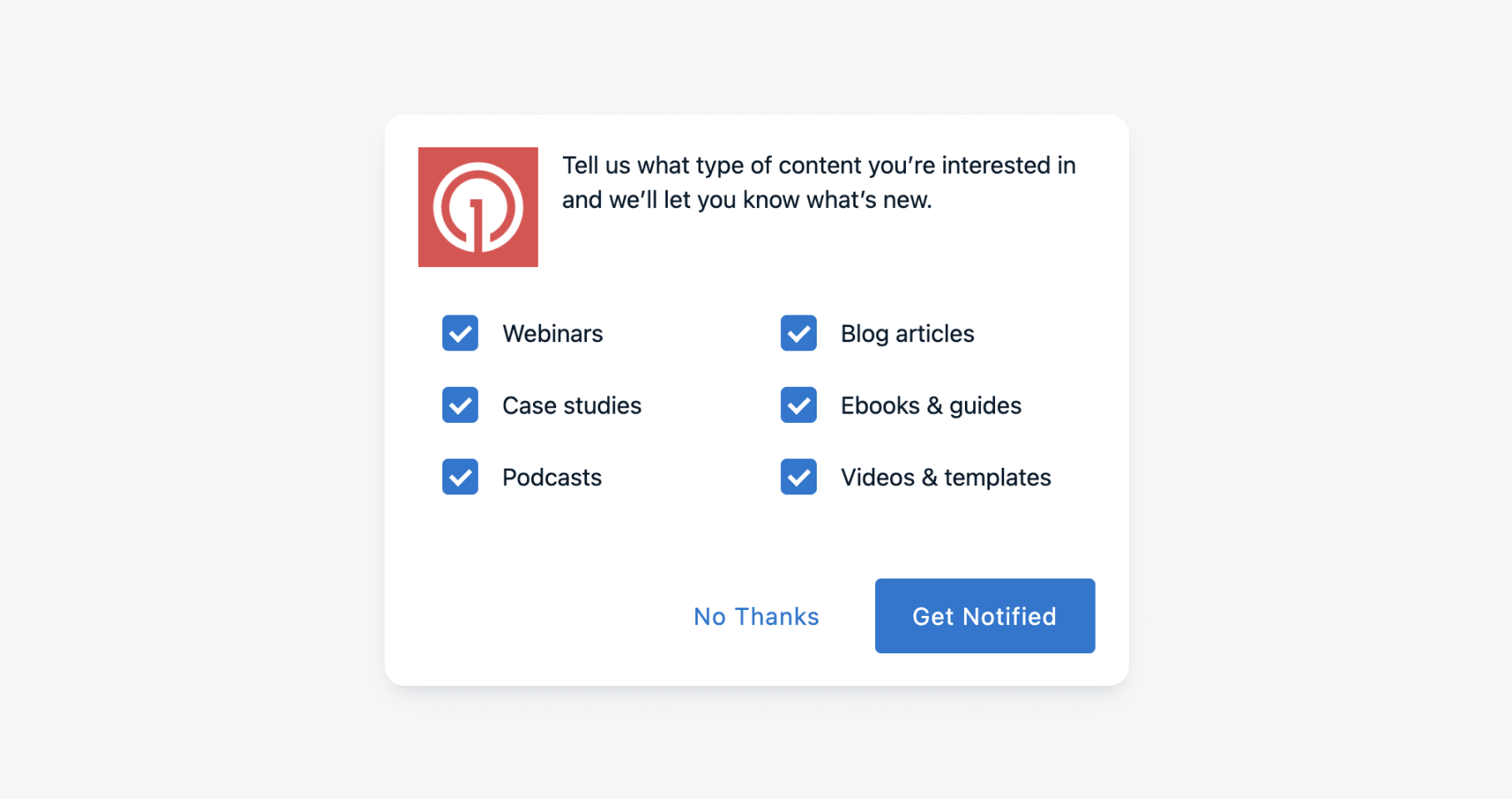
Image Description: The OneSignal email newsletter prompt allows visitors to choose what types of email updates they’d like to receive.
Additionally, consider including an "Unsubscribe" or "Opt-Out" option that allows users to decline all communications. Ensure this option is easy to find and clearly labeled.
For legal and ethical reasons, it's generally recommended to have opt-in by default, meaning users should actively select the types of communication they want to receive.
Use straightforward language that clearly indicates whether a checkbox represents opting in or opting out. Avoid confusing or ambiguous labels.
Privacy and Data Sharing
Offer users control over how their data is used and shared, including options for data collection and sharing with third parties. Clearly communicating how user data is collected, stored, and used fosters transparency and demonstrates your organization's commitment to ethical data practices. But it’s not enough to simply demonstrate your knowledge of these regulations, you have to follow them too! Many data protection regulations require explicit user consent for data processing. Allowing users to control their data preferences ensures compliance with these regulations.
If applicable, inform users whether their data will be shared with third parties, such as partners or affiliates. Clearly state the reasons for such sharing. If data sharing with third parties is optional, present an opt-in option that allows users to choose whether their data can be shared beyond your organization.
Provide a link to your organization's privacy policy, where users can find detailed information about data handling practices.
User Preference Center Examples
Let’s look at a couple of real-life preference center examples, along with what they did right and wrong.
Poor Preference Example #1
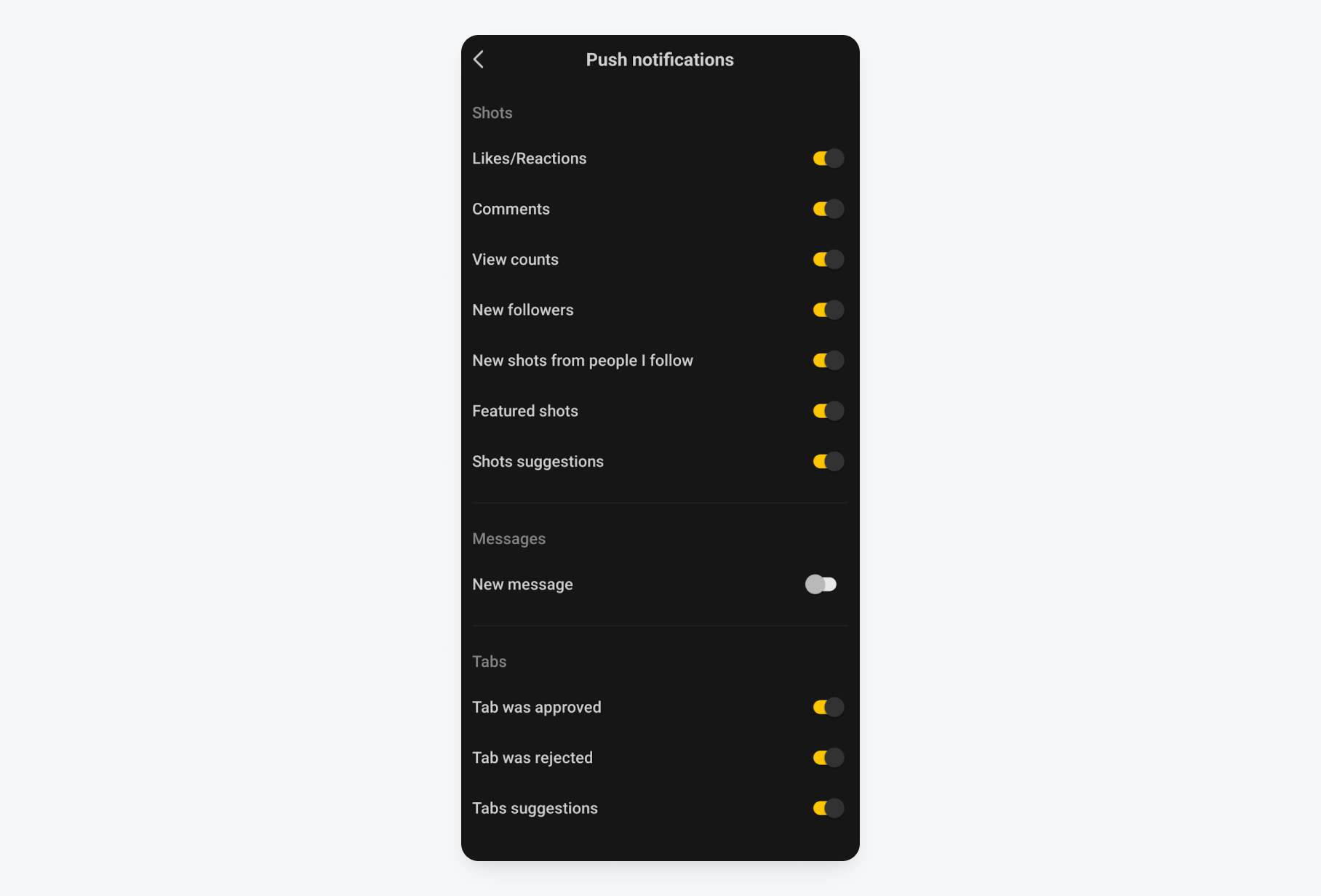
The user preference center for this popular guitar tab app features a series of toggles for their push notification messaging. While thoughtfully designed with the brand’s color scheme, this preference center example suffers from poor content formatting. They have over-segmented their options, resulting in an experience that only inspires user eyes to glaze over an overly long list of options.
Additionally, they leave out all context for explaining what some of these features are or the benefits they carry with them. What is a “shot” and why should I care about being notified about one?
Poor Preference Example #2
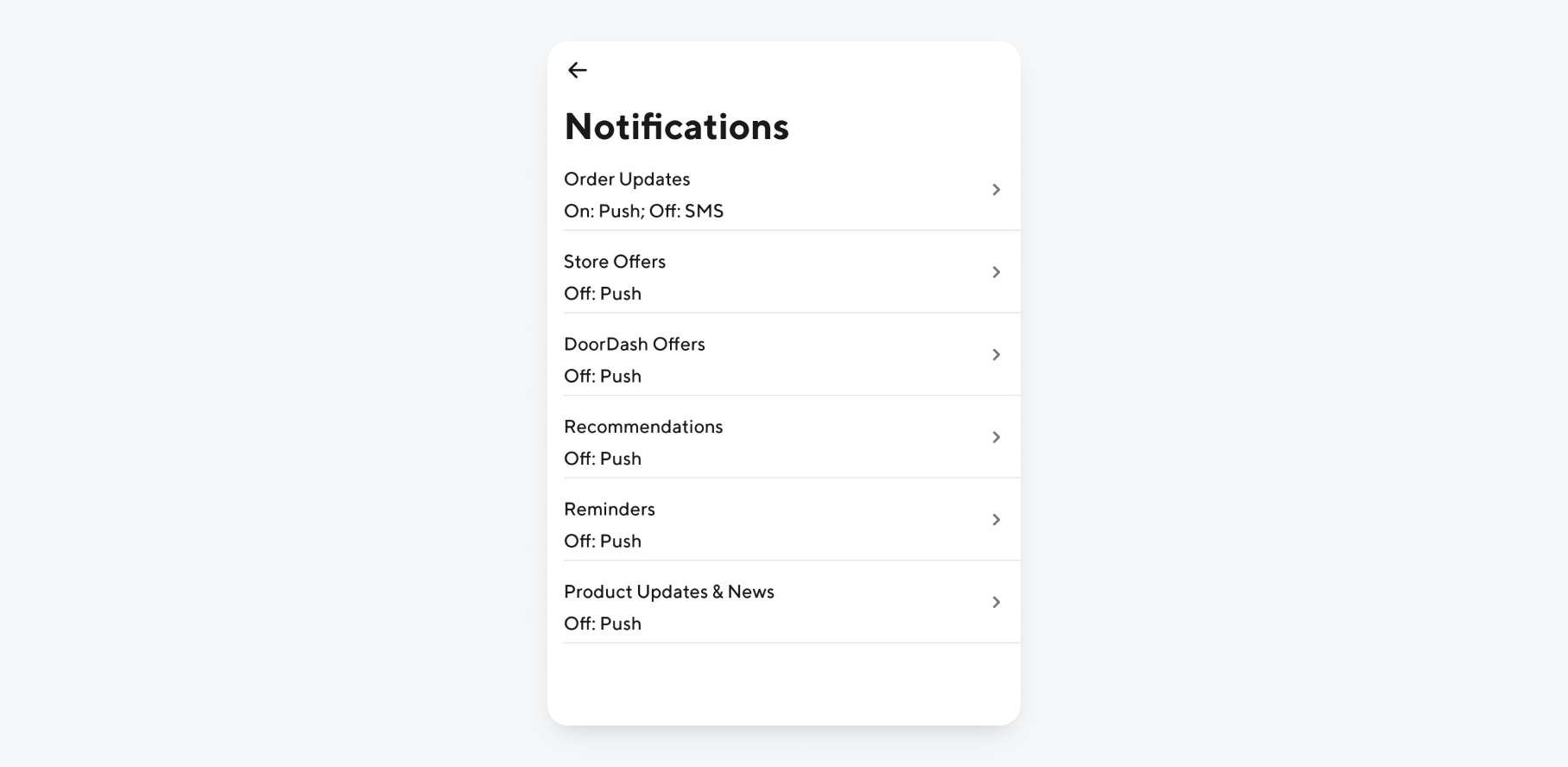
This user preference center offers customization options that make sense on a category-by-category level, however, it’s just plain hard to make sense of. “Off: Push” is not a natural or intuitive way to express these settings! We have already been conditioned (as both app users and human beings) to read left to right and have our digital interfaces reflect a bold, simplistic format. This preference center accomplishes neither!
Strong Preference Center Example #1
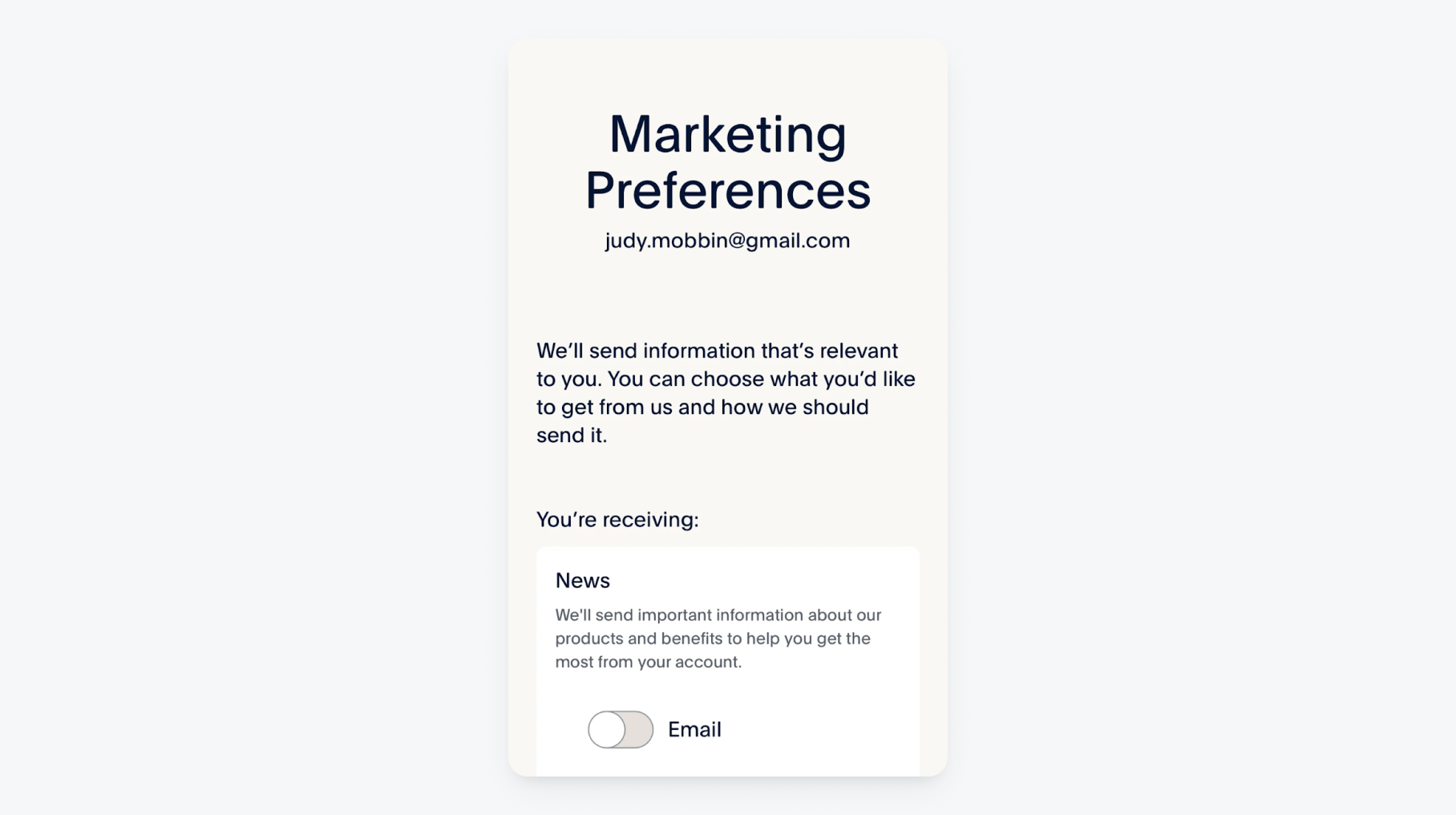
PayPal’s preference center does a wonderful job of reinforcing, upfront, the importance of curating your own experience. You’re here to choose content relevant to your interests! They have also designed their preference toggles with action-oriented language and a foolproof interface.

Notice, they include a disclaimer reminding users that they will still receive transactional messages regarding sensitive account info, outside of any marketing campaigns.
Strong Preference Center Example #2
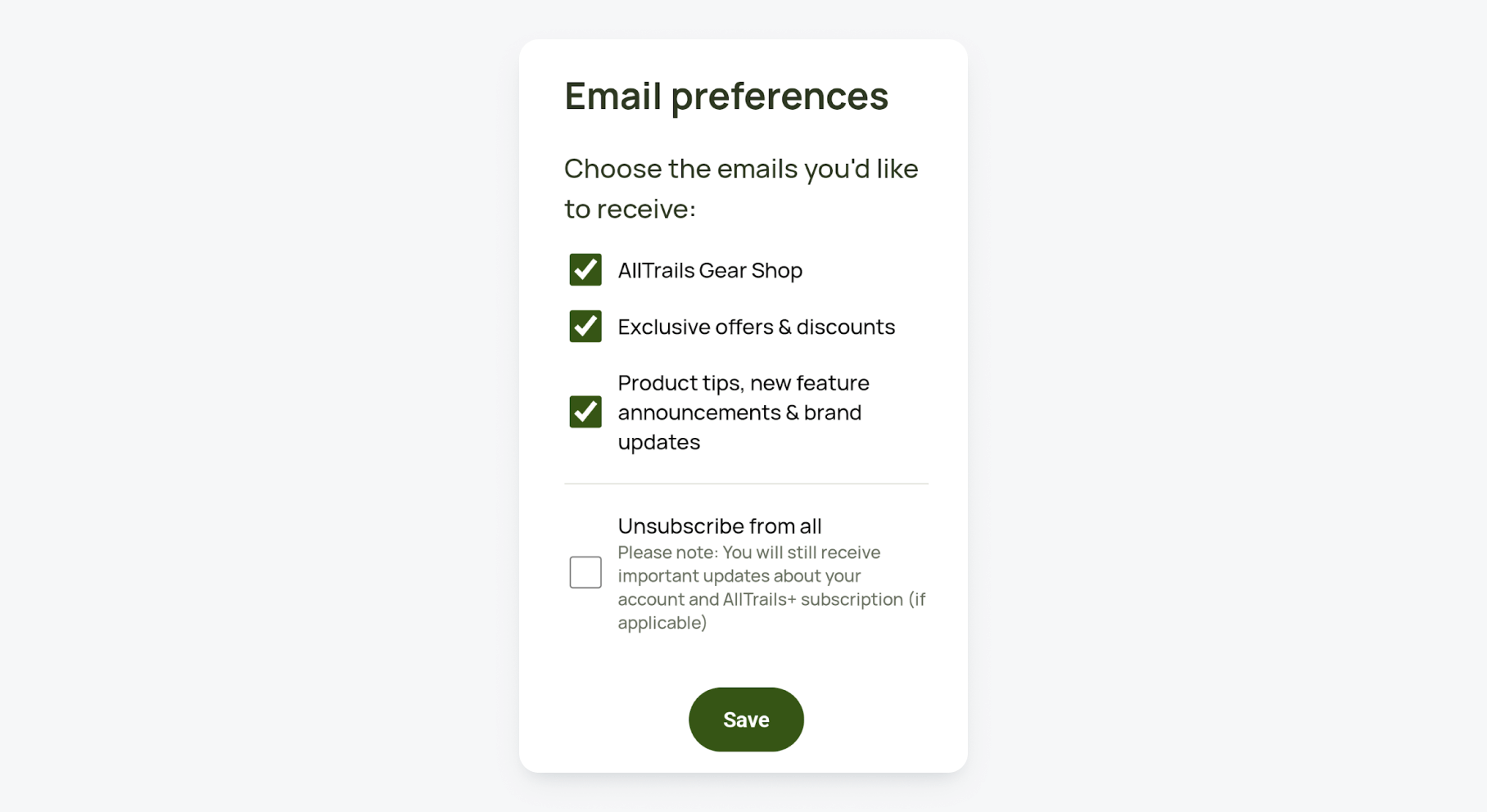
This user email preference center from the outdoor hiking app, AllTrails, exceeds in its simplicity and at-a-glance design. They also include an “unsubscribe from all” option to make life much easier for users who wish to quickly and easily escape any and all notifications. And again, we see an intentionally placed disclaimer clarifying the continuation of important app purchase information.
Could there be a little more context for what “AllTrails Gear Shop” notifications are or why we should care about new feature announcements? Sure. However, the fact that this user preference center makes it impossible to get lost makes it a humble success in our eyes.
Use OneSignal to Centralize Your User Preferences
Whether you’re syncing your existing preference center to OneSignal or you’re ready to build your own, custom unsubscribe page, we are ready to help you get started. OneSignal allows you to track unsubscribe changes back to your app and tailor notifications based on different subscription segments to make your content lightyears more relevant than your competition.
Get Started for Free!



